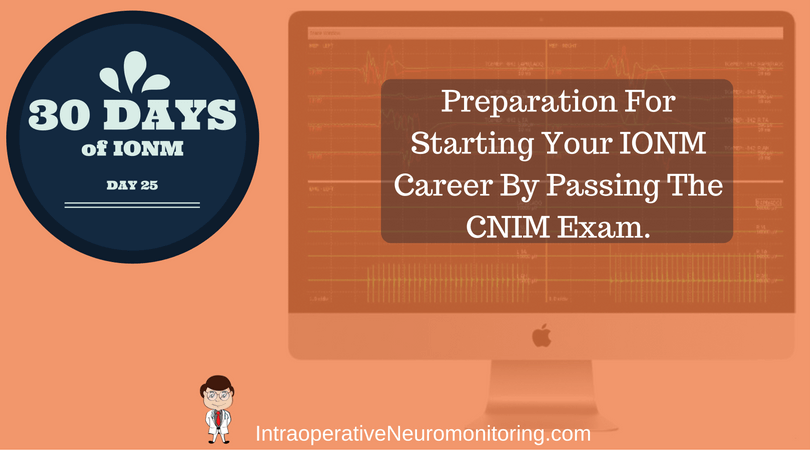How to study for the CNIM exam and PASS!
(Joe’s Notes: A part of my brain fails to comprehend the vast differences in backgrounds people in the IONM community have and the fact that many of the readers are just starting their IONM career. I end up jumping into articles that dive deep into the generators created in the N13a and N13b SSEP responses or recognizing situations when to switch from alternating clicks to rarefaction in ABR responses instead of starting at the beginning for CNIM exam prep.
So instead of dealing with my own inadequacies, I asked my colleague, Tom McGee, to share some of his recommendations pertaining to the “preparatory process” for taking the CNIM examination. Instead of what you need to know today for a test tomorrow, I asked him to help formulate a plan that people can have on their calendar months out from the exam, similar to the process we use at a large neuromonitoring company, as well as introduce those looking to get into the field to the certification process. And start at the beginning, like we all did at some point.
Here’s the question I posed to Tom for this article…
“If I just started IONM today and wanted to get a jump start on preparing for the CNIM exam, and you had no idea who I was or what my background was, what advice would you give me that has worked for you and others if you only had 3 minutes to tell me?”)
Preparing For The CNIM Exam
I know what you’re thinking…. Some of you are asking, “I can pass the CNIM?” Others are saying, “Cool, great tips and tricks to pass this test!” And still others are asking, “What’s a CNIM?” Yes, these are great questions. Let’s take a look at them, starting with the last one.
What is [a] CNIM? Get ready for some acronyms! CNIM (Certification in Neurophysiologic Intraoperative Monitoring) is a designation conferred by the American Board of Registration of Electroencephalographic and Evoked Potential Technologists, or ABRET, when one passes the certification examination. The CNIM credential is the desired credential for those who are not doctorate level folks, but do want to be in the field of intraoperative monitoring. For curiosity’s sake, the doctorate level credential that I’m referring to is the DABNM (Diplomate of the American Board of Neurophysiological Monitoring).
For those of you who were thinking that this article would include great tips and tricks to pass the CNIM exam, we are here! Reader, understand that I’m not a compensated endorser for any of the materials above or below, but rather I’m sharing with you resources that I have found to be quite helpful.
- Build on a solid foundation. Enroll in a course that provides a framework for studying the many sections of the CNIM exam. Sentient Medical and SpecialtyCare, for instance, both have such a CNIM prep course. The course runs for a few months leading up to the examination dates. During that lead time, there are intensive sections that guide the learner through the areas in which they can be tested. Another example of the prep course is found on this website. Joe Hartman has also come up with a CNIM prep course that is available to those in the open marketplace.
- Study the guidelines published by the American Clinical Neurophysiological Society. You’ll find a great deal of information in those pages on which the CNIM examination was based. For IOM directed studies, focus on the Evoked Potentials (9A, 9B, 9C, and 9D) and the IOM specific guidelines (11A, 11B, 11C, and 15). Understand that some of this information is out of date, and to be sensitive to differences in some of the details you read.
- There are two major societies associated with Intraoperative Monitoring (aset.org and asnm.org). Each of them has position papers associated with intraoperative monitoring and patient care in the END (ElectroNeuroDiagnostic) environment. These position papers are found on the main pages with just a bit of looking.
- Read books associated with Intraoperative Monitoring. Two that come to mind:
- Principles of Neurophysiologic Assessment, Mapping, and Monitoring by Kaye and Davis;
- Intraoperative Neurophysiology by Simon
- Read other scholarly articles on intraoperative monitoring. Google.com is a great resource – some search results have the full text available, others, just the abstract. If you live in an area with a medical school, sometimes you can ask nicely for some time at their computers and search. Personal note: Years ago, I used to spend a Saturday or two a month reading literature from a range of subjects such as cardiology, neurology, and even ventured into Chinese medicine (the medical school library by me had a number of references on this subject).
- Next, and this is not an all-encompassing list, but take this advice from the ABRET website when it comes to studying for an examination. This article reinforces first about the non-disclosure of test questions, and toward the end of the article, there are four more keys:
- Be wary in selecting a training program in the open marketplace. Again, the two mentioned above I have seen great track records for success. More about that shortly.
- Be wary of programs that offer a 100% guarantee for passing the CNIM exam.
- Be wary of the so-called brain dump websites that may or may not be filled with questions from previous test takers, and which may or may not be useful in studying.
- Report those sources that have been reported to be using actual test questions.
- Lastly, and I believe most importantly, you get out what you put into the studying. If you have a laissez-faire approach to studying, chances are you will not be satisfied with your test result. Personally, when I took the CNIM test years ago, the test was still paper and pencil, not computer – yeah, I know I’m old. But I also printed off everything that I could possibly find, including the guidelines above, and stuffed binders full of the papers. Then I studied every day for the three months leading up to the examination. Sentient also had a test bank from which practice examinations were taken, and I took at least one practice test per week, if not more.
Wow, that was a lot of stuff! Now for the final question: I can pass the CNIM exam?
Sentient Medical has the in-house CNIM prep course as I mentioned above. We on the education team are able to objectively assess the participation levels of those in the class, and what we’ve seen test group after test group, is that those who are consistently scoring above 80% in practice examinations and have been faithful to the reading and associated homework pass the examination. The reverse is generally seen as well.
I would be a fool to say that you are guaranteed to pass the CNIM examination, but your chances are improved if:
- The more time you spend with the material, the better your retention should be;
- The more you test yourself, the better your scores should become;
- Give yourself months to absorb the material, not weeks
- Be a self-starter. If you’re going to rely others and structure to ‘make’ you pass, you aren’t.
That’s it! YOU can PASS the CNIM if you take advantage of the resources above AND you put in the proper amount of self-determined effort to learn, retain, and regurgitate the information on the exam.

Thomas McGee, CNIM
Director of Training in Surgical Neurophysiology
Tom has transitioned from Regional Director and upper management to his current role of Director of Training and Education. He now oversees the management of Sentient Medical’s Clinical Trainers, as well leads classroom lectures for Sentient’s Fellowship program and creation (and on-going tinkering) of their CNIM coursework.
Want new articles before they get published?
Subscribe to our Awesome Newsletter.
1 Comment
Keep Learning
Here are some related guides and posts that you might enjoy next.
How To Have Deep Dive Neuromonitoring Conversations That Pays Off…
How To Have A Neuromonitoring Discussion One of the reasons for starting this website was to make sure I was part of the neuromonitoring conversation. It was a decision I made early in my career... and I'm glad I did. Hearing the different perspectives and experiences...
Intraoperative EMG: Referential or Bipolar?
Recording Electrodes For EMG in the Operating Room: Referential or Bipolar? If your IONM manager walked into the OR in the middle of your case, took a look at your intraoperative EMG traces and started questioning your setup, could you defend yourself? I try to do...
BAER During MVD Surgery: A New Protocol?
BAER (Brainstem Auditory Evoked Potentials) During Microvascular Decompression Surgery You might remember when I was complaining about using ABR in the operating room and how to adjust the click polarity to help obtain a more reliable BAER. But my first gripe, having...
Bye-Bye Neuromonitoring Forum
Goodbye To The Neuromonitoring Forum One area of the website that I thought had the most potential to be an asset for the IONM community was the neuromonitoring forum. But it has been several months now and it is still a complete ghost town. I'm honestly not too...
EMG Nerve Monitoring During Minimally Invasive Fusion of the Sacroiliac Joint
Minimally Invasive Fusion of the Sacroiliac Joint Using EMG Nerve Monitoring EMG nerve monitoring in lumbar surgery makes up a large percentage of cases monitored every year. Using EMG nerve monitoring during SI joint fusions seems to be less utilized, even though the...
Physical Exam Scope Of Practice For The Surgical Neurophysiologist
SNP's Performing A Physical Exam: Who Should Do It And Who Shouldn't... Before any case is monitored, all pertinent patient history, signs, symptoms, physical exam findings and diagnostics should be gathered, documented and relayed to any oversight physician that may...








I would like to study and pass the CNIM exam to better, supply a caring and understandingsupport my patients as each patient is treated as my own family member. I would also like to be able to financially support my family.